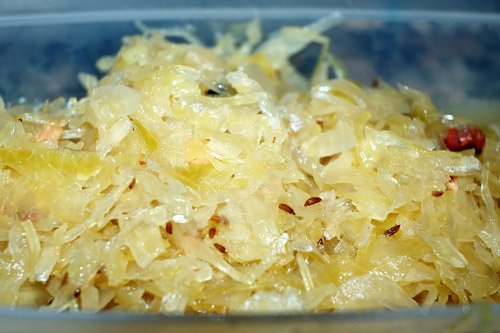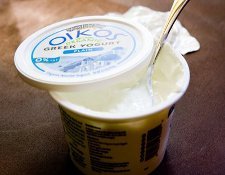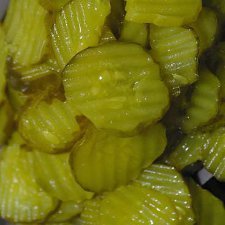 Naturally fermented foods are some of the best nutrition on the planet. You don’t have to take my word for it though, since the Chinese have eaten these foods for around 6,000 years!
Naturally fermented foods are some of the best nutrition on the planet. You don’t have to take my word for it though, since the Chinese have eaten these foods for around 6,000 years!
Whether you prefer sauerkraut, kimchi, yogurt, or miso, fermented foods can give you a huge nutritional boost for very little cost and effort. Check out the process and why it’s so amazingly healthy and simple!
What Is Lacto-Fermentation?
 Most simply, lacto-fermentation is the process of preserving food by exposing it to the bacteria lactobacillus. You’ve probably heard of it, since it’s the active culture in most kinds of yogurt. Almost all vegetables have this bacteria naturally occurring their surfaces, and it’s present in dairy products. It can also be added to foods to speed the fermentation process.
Most simply, lacto-fermentation is the process of preserving food by exposing it to the bacteria lactobacillus. You’ve probably heard of it, since it’s the active culture in most kinds of yogurt. Almost all vegetables have this bacteria naturally occurring their surfaces, and it’s present in dairy products. It can also be added to foods to speed the fermentation process.
When you close up the veggies in an airtight container, the bacteria get to work. They digest the sugars and starches in the food, turning them into lactic acid and carbon dioxide. This is an ancient and effective form of food preservation.
Lacto-fermentation gives food a unique set of flavors that most people don’t experience. They’re slightly effervescent because of the CO2, and are generally tangy. This tanginess differs from traditional “pickled” flavors (such as vinegar or citrus), however, and is best experienced rather than described.
Body Benefits
 The foremost expert on fermented foods, Sally Fallon, has this to say about the benefits of eating these nutrient-dense foods:
The foremost expert on fermented foods, Sally Fallon, has this to say about the benefits of eating these nutrient-dense foods:
“The proliferation of lactobacilli in fermented vegetables enhances their digestibility and increases vitamin levels. These beneficial organisms produce numerous helpful enzymes as well as antibiotic and anticarcinogenic substances. Their main by-product, lactic acid, not only keeps vegetables and fruits in a state of perfect preservation but also promotes the growth of healthy flora throughout the intestine.” Nourishing Traditions, pg. 89
Lactobacillus causes beneficial probiotics to be cultivated in the food it’s preserving. It also produces precious B vitamins as well as vitamin K. Delicate vitamins like C are often lost during conventional preservation methods, but are well preserved in lacto-fermented foods.
Because the bacteria do much of the digestive work for us, the body doesn’t have to work as hard to digest. This is particularly important, as many people avoid hard vegetables and dairy products due to the havoc they can wreak on the tummy. With lacto-fermentation, this is often a non-issue.
Another benefit is the neutralization of phytic acid and oxalates. If you struggle with thyroid problems, this is especially important, but many people choose to avoid phytates and oxalates in the course of discovering what sort of diet works best for their own bodies.
This type of preservation can even make the dreaded soy reasonable. Yes, I said it. You can eat small amounts of fermented soy products, so long as it’s naturally fermented as opposed to most mainstream products.
What to Avoid
Now that I’ve got you all excited for fermented foods, I’ve got to warm you about a few things. Even though pickles, olives, and sauerkraut are available in lacto-fermented varieties, not all of what’s available in the marketplace is packed with health and nutrition.
For a food to be safe and lacto-fermented, they must be either homemade from a recipe (and a trusted, preferably organic food source) or purchased from the refrigerated section of a store. The packaging should say “live and active cultures.” In short, if it doesn’t have cultures on the label, it’s not beneficial!
Another place you’ll sometimes see lacto-fermented foods is on the food bar at places like Whole Foods. You’ll often find Greek olives there, and more rarely, sauerkraut. You can find fresh pickles and sauerkraut in delis and small eateries in ethnic areas of town (especially, in my experience, Jewish and Korean boroughs). Check them out if you don’t have time to make your own!
Recipes
 Pickles
Pickles
Modified slightly from Shanna Ohmes
One of the quickest things to make is pickles, and it only takes three days instead of three weeks like sauerkraut. These are delicious!
- 4-5 cucumbers
- 1 tablespoon Real Salt
- 4 tablespoons whey
- 1 tablespoon mustard seeds
- 2 tablespoons dill seed
- 1 cup filtered water
- 1 quart canning jar
How to make the whey: I set out a carton of plain yogurt in a cheesecloth lined strainer over a large bowl. Leave this out 12-24 hours or overnight. The liquid that drains off the yogurt is the whey and has lots of health benefits. The resulting yogurt will be nice and thick, so I add some berries and a touch of honey and have it for breakfast!
I slice the cucumbers about 1/4″ thick and put them in the jar. I combine the rest of the ingredients and pour over the cucumbers. Make sure the liquid covers the pickles and still leaves about 1″ headroom. Add more water if it still needs liquid. Let set out on your kitchen counter for about 3 days and then transfer to your refrigerator.
Kefir
Recipe from Rebecca Wood
This is perhaps the easiest and most nutritious of the lacto-fermented foods, so be sure to start using kefir if you can tolerate dairy.
- 1 tablespoon kefir grains
- 1 scant quart milk (goat, cow, pasteurized, raw, reconstituted, skim or full fat)
Place kefir grains and milk in a quart glass jar. Tightly cover and set out at room temperature for 24-48 hours (in hot weather, it ferments faster) but not in direct sun light. Shake the bottle a couple times during fermentation.
After shaking, release any CO2 gas buildup by opening the lid, then tighten the lid once again. (A tight lid produces a lightly effervescent beverage. To eliminate effervescence, just rest the lid on the jar rather than tightly closing the lid.)
The kefir is ready when the grains coagulate at the top of the jar. To separate the newly made kefir and to retrieve the kefir grains, pour through a strainer or colander (stirring as necessary to prevent the grains from clogging the strainer).
You may drink the kefir as is, or you may refrigerate it for up to three weeks. Or, as per below, you may further ripen the kefir. But, and this is important, don’t discard the grains.
To make a new batch of kefir, add these retrieved grains to fresh milk and repeat the process. Or, to refrigerate the grains until next use, place grains with kefir to cover in a tightly closed jar. They’ll hold for several weeks. To hold longer, place grains in quart of fresh milk, refrigerate for up to a month (shake the container several times a week).
Kimchi
Recipe from David Lebovitz
People either love or hate this Korean fermented cabbage. No self-respecting Korean would ever buy kimchi in the market, and this is pretty simple to make. Give it a try!
- 1 large Chinese or Napa Cabbage
- 1 gallon (4l) water
- 1/2 cup (100g) coarse salt
- 1 small head of garlic, peeled and finely minced
- one 2-inch (6cm) piece of fresh ginger, peeled and minced
- 1/4 cup (60ml) fish sauce
- 1/3 cup (80ml) chili paste or 1/2 cup Korean chili powder
- 1 bunch green onions, cut into 1-inch (3cm) lengths (use the dark green part, too, except for the tough ends)
- 1 medium daikon radish, peeled and grated
- 1 teaspoon honey
1. Slice the cabbage lengthwise in half, then slice each half lengthwise into 3 sections. Cut away the tough stem chunks.
2. Dissolve the salt in the water in a very large container, then submerge the cabbage under the water. Put a plate on top to make sure they stay under water, then let stand for 2 hours. Mix the other ingredients in a very large metal or glass bowl.
3. Drain the cabbage, rinse it, and squeeze it dry. Here’s the scary part: mix it all up. Some recipes advise wearing rubber gloves since the chili paste can stain your hands.
4. Pack the kimchi in a clean glass jar large enough to hold it all and cover it tightly. Let stand for one to two days in a cool place, around room temperature. Check the kimchi after 1-2 days. If it’s bubbling a bit, it’s ready and should be refrigerated. If not, let it stand another day, when it should be ready. Once it’s fermenting, serve or store in the refrigerator. If you want, add a sprinkle of toasted sesame seeds over the kimchi for serving.
Well there you have it! Easy, delicious recipes for foods that will improve your health and cost pennies to make. Can’t beat that!